Plesiosaur
| Plesiosauria | |
|---|---|

| |
| Restored skeleton of Plesiosaurus | |

| |
| Skeletal mount of Peloneustes | |
| Scientific classification | |
| Domain: | Eukaryota |
| Kingdom: | Animalia |
| Phylum: | Chordata |
| Class: | Reptilia |
| Superorder: | †Sauropterygia |
| Clade: | †Pistosauria |
| Order: | †Plesiosauria Blainville, 1835 |
| Subgroups | |
| |
The Plesiosauria (/ˌpliːsiəˈsɔːriə, -zi-/ PLEE-see-ə-SOR-ee-ə, -zee-;[2][3] Greek: πλησίος, plesios, meaning "near to" and sauros, meaning "lizard")[4] or plesiosaurs are an order or clade of extinct Mesozoic marine reptiles, belonging to the Sauropterygia.
Plesiosaurs first appeared in the latest
Plesiosaurs were among the first fossil reptiles discovered. In the beginning of the nineteenth century, scientists realised how distinctive their build was and they were named as a separate order in 1835. The first plesiosaurian genus, the eponymous Plesiosaurus, was named in 1821. Since then, more than a hundred valid species have been described. In the early twenty-first century, the number of discoveries has increased, leading to an improved understanding of their anatomy, relationships and way of life.
Plesiosaurs had a broad flat body and a short tail. Their limbs had evolved into four long flippers, which were powered by strong muscles attached to wide bony plates formed by the shoulder girdle and the pelvis. The flippers made a flying movement through the water. Plesiosaurs breathed air, and bore live young; there are indications that they were warm-blooded.
Plesiosaurs showed two main morphological types. Some species, with the "plesiosauromorph" build, had (sometimes extremely) long necks and small heads; these were relatively slow and caught small sea animals. Other species, some of them reaching a length of up to seventeen metres, had the "pliosauromorph" build with a short neck and a large head; these were apex predators, fast hunters of large prey. The two types are related to the traditional strict division of the Plesiosauria into two suborders, the long-necked Plesiosauroidea and the short-neck Pliosauroidea. Modern research, however, indicates that several "long-necked" groups might have had some short-necked members or vice versa. Therefore, the purely descriptive terms "plesiosauromorph" and "pliosauromorph" have been introduced, which do not imply a direct relationship. "Plesiosauroidea" and "Pliosauroidea" today have a more limited meaning. The term "plesiosaur" is properly used to refer to the Plesiosauria as a whole, but informally it is sometimes meant to indicate only the long-necked forms, the old Plesiosauroidea.
History of discovery
Early finds
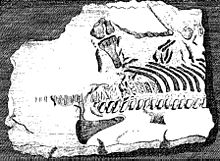
Skeletal elements of plesiosaurs are among the first fossils of extinct reptiles recognised as such.
In 1719,

During the eighteenth century, the number of English plesiosaur discoveries rapidly increased, although these were all of a more or less fragmentary nature. Important collectors were the reverends William Mounsey and Baptist Noel Turner, active in the Vale of Belvoir, whose collections were in 1795 described by John Nicholls in the first part of his The History and Antiquities of the County of Leicestershire.[11] One of Turner's partial plesiosaur skeletons is still preserved as specimen BMNH R.45 in the British Museum of Natural History; this is today referred to Thalassiodracon.[7]
Naming of Plesiosaurus

In the early nineteenth century, plesiosaurs were still poorly known and their special build was not understood. No systematic distinction was made with
Soon afterwards, the morphology became much better known. In 1823, Thomas Clark reported an almost complete skull, probably belonging to Thalassiodracon, which is now preserved by the British Geological Survey as specimen BGS GSM 26035.[7] The same year, commercial fossil collector Mary Anning and her family uncovered an almost complete skeleton at Lyme Regis in Dorset, England, on what is today called the Jurassic Coast. It was acquired by the Duke of Buckingham, who made it available to the geologist William Buckland. He in turn let it be described by Conybeare on 24 February 1824 in a lecture to the Geological Society of London,[15] during the same meeting in which for the first time a dinosaur was named, Megalosaurus. The two finds revealed the unique and bizarre build of the animals, in 1832 by Professor Buckland likened to "a sea serpent run through a turtle". In 1824, Conybeare also provided a specific name to Plesiosaurus: dolichodeirus, meaning "longneck". In 1848, the skeleton was bought by the British Museum of Natural History and catalogued as specimen BMNH 22656.[7] When the lecture was published, Conybeare also named a second species: Plesiosaurus giganteus. This was a short-necked form later assigned to the Pliosauroidea.[16]
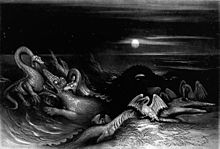
Plesiosaurs became better known to the general public through two lavishly illustrated publications by the collector
During the first half of the nineteenth century, the number of plesiosaur finds steadily increased, especially through discoveries in the sea cliffs of Lyme Regis. Sir Richard Owen alone named nearly a hundred new species. The majority of their descriptions were, however, based on isolated bones, without sufficient diagnosis to be able to distinguish them from the other species that had previously been described. Many of the new species described at this time have subsequently been invalidated. The genus Plesiosaurus is particularly problematic, as the majority of the new species were placed in it so that it became a wastebasket taxon. Gradually, other genera were named. Hawkins had already created new genera, though these are no longer seen as valid. In 1841, Owen named Pliosaurus brachydeirus. Its etymology referred to the earlier Plesiosaurus dolichodeirus as it is derived from πλεῖος, pleios, "more fully", reflecting that according to Owen it was closer to the Sauria than Plesiosaurus. Its specific name means "with a short neck".[21] Later, the Pliosauridae were recognised as having a morphology fundamentally different from the plesiosaurids. The family Plesiosauridae had already been coined by John Edward Gray in 1825.[22] In 1835, Henri Marie Ducrotay de Blainville named the order Plesiosauria itself.[23]
American discoveries
In the second half of the nineteenth century, important finds were made outside of England. While this included some German discoveries, it mainly involved plesiosaurs found in the sediments of the American Cretaceous

In 1867, physician Theophilus Turner near
Around the turn of the century, most plesiosaur research was done by a former student of Marsh, Professor Samuel Wendell Williston. In 1914, Williston published his Water reptiles of the past and present.[33] Despite treating sea reptiles in general, it would for many years remain the most extensive general text on plesiosaurs.[34] In 2013, a first modern textbook was being prepared by Olivier Rieppel. During the middle of the twentieth century, the USA remained an important centre of research, mainly through the discoveries of Samuel Paul Welles.
Recent discoveries
Whereas during the nineteenth and most of the twentieth century, new plesiosaurs were described at a rate of three or four novel genera each decade, the pace suddenly picked up in the 1990s, with seventeen plesiosaurs being discovered in this period. The tempo of discovery accelerated in the early twenty-first century, with about three or four plesiosaurs being named each year.[35] This implies that about half of the known plesiosaurs are relatively new to science, a result of a far more intense field research. Some of this is taking place away from the traditional areas, e.g. in new sites developed in New Zealand, Argentina, Chile,[36] Norway, Japan, China and Morocco, but the locations of the more original discoveries have proven to be still productive, with important new finds in England and Germany. Some of the new genera are a renaming of already known species, which were deemed sufficiently different to warrant a separate genus name.
In 2002, the "
In 2004, what appeared to be a completely intact juvenile plesiosaur was discovered, by a local fisherman, at
In 2005, the remains of three plesiosaurs (
In 2006, a combined team of American and Argentinian investigators (the latter from the Argentinian Antarctic Institute and the La Plata Museum) found the skeleton of a juvenile plesiosaur measuring 1.5 metres (4 ft 11 in) in length on Vega Island in Antarctica.[43] The fossil is currently on display at the geological museum of South Dakota School of Mines and Technology.[44]
In 2008, fossil remains of an undescribed plesiosaur that was named
In December 2017, a large skeleton of a plesiosaur was found in the continent of Antarctica, the oldest creature on the continent, and the first of its species in Antarctica.[47]
Not only has the number of field discoveries increased, but also, since the 1950s, plesiosaurs have been the subject of more extensive theoretical work. The methodology of cladistics has, for the first time, allowed the exact calculation of their evolutionary relationships. Several hypotheses have been published about the way they hunted and swam, incorporating general modern insights about biomechanics and ecology. The many recent discoveries have tested these hypotheses and given rise to new ones.[original research?]
Evolution
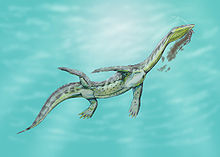
The Plesiosauria have their origins within the

From the earliest
The
In the middle of the Jurassic, very large Pliosauridae evolved. These were characterized by a large head and a short neck, such as Liopleurodon and Simolestes. These forms had skulls up to three metres (ten feet) long and reached a length of up to seventeen metres (56 feet) and a weight of ten tonnes. The pliosaurids had large, conical teeth and were the dominant marine carnivores of their time. During the same time, approximately 160 million years ago, the Cryptoclididae were present, shorter species with a long neck and a small head.[54]
The Leptocleididae radiated during the Early Cretaceous. These were rather small forms that, despite their short necks, might have been more closely related to the Plesiosauridae than to the Pliosauridae. Later in the Early Cretaceous, the Elasmosauridae appeared; these were among the longest plesiosaurs, reaching up to fifteen metres (fifty feet) in length due to very long necks containing as many as 76 vertebrae, more than any other known vertebrate. Pliosauridae were still present as is shown by large predators, such as Kronosaurus.[54]
At the beginning of the Late Cretaceous, the Ichthyosauria became extinct; perhaps a plesiosaur group evolved to fill their niches: the Polycotylidae, which had short necks and peculiarly elongated heads with narrow snouts. During the Late Cretaceous, the elasmosaurids still had many species.[54]
All plesiosaurs became
Relationships
In modern
Another way to define a clade is to let it consist of all species more closely related to a certain species that one in any case wishes to include in the clade than to another species that one to the contrary desires to exclude. Such a clade is called a "
Benson et al. (2012) found the traditional Pliosauroidea to be
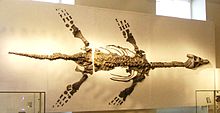
The following cladogram follows an analysis by Benson & Druckenmiller (2014).[57]
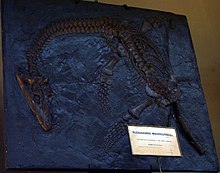
| ||||||||||||||||||||||
Description
Size
In general, plesiosaurians varied in adult length from between 1.5 metres (4.9 ft) to about 15 metres (49 ft). The group thus contained some of the largest marine
Skeleton
The typical plesiosaur had a broad, flat, body and a short
To power the flippers, the
To become flippers, the limbs had changed considerably. The limbs were very large, each about as long as the trunk. The forelimbs and hindlimbs strongly resembled each other. The

While plesiosaurs varied little in the build of the trunk, and can be called "conservative" in this respect, there were major differences between the subgroups as regards the form of the neck and the skull. Plesiosaurs can be divided into two major morphological types that differ in head and
The skull of plesiosaurs showed the "
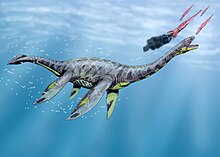
The tooth form and number was very variable. Some forms had hundreds of needle-like teeth. Most species had larger conical teeth with a round or oval cross-section. Such teeth numbered four to six in the premaxilla and about fourteen to twenty-five in the maxilla; the number in the lower jaws roughly equalled that of the skull. The teeth were placed in tooth-sockets, had vertically wrinkled enamel and lacked a true cutting edge or carina. With some species, the front teeth were notably longer, to grab prey.[69]
Soft tissues
Soft tissue remains of plesiosaurs are rare, but sometimes, especially in
Paleobiology

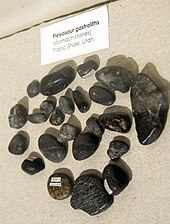
Food
The probable food source of plesiosaurs varied depending on whether they belonged to the long-necked "plesiosauromorph" forms or the short-necked "pliosauromorph" species.
The extremely long necks of "plesiosauromorphs" have caused speculation as to their function from the very moment their special build became apparent. Conybeare had offered three possible explanations. The neck could have served to intercept fast-moving fish in a pursuit. Alternatively, plesiosaurs could have rested on the sea bottom, while the head was sent out to search for prey, which seemed to be confirmed by the fact the eyes were directed relatively upwards. Finally, Conybeare suggested the possibility that plesiosaurs swam on the surface, letting their necks plunge downwards to seek food at lower levels. All these interpretations assumed that the neck was very flexible. The modern insight that the neck was, in fact, rather rigid, with limited vertical movement, has necessitated new explanations. One hypothesis is that the length of the neck made it possible to surprise schools of fish, the head arriving before the sight or pressure wave of the trunk could alert them. "Plesiosauromorphs" hunted visually, as shown by their large eyes, and perhaps employed a directional sense of olfaction. Hard and soft-bodied cephalopods probably formed part of their diet. Their
The short-necked "pliosauromorphs" were top carnivores, or
Plesiosaurs were themselves prey for other carnivores, as shown by bite marks left by a shark that have been discovered on a fossilized plesiosaur fin[84] and the fossilized remains of a mosasaur's stomach contents that are thought to be the remains of a plesiosaur.[85]
Skeletons have also been discovered with
Locomotion
Flipper movement
The distinctive four-flippered body-shape has caused considerable speculation about what kind of stroke plesiosaurs used. The only modern group with four flippers are the sea turtles, which only use the front pair for propulsion. Conybeare and Buckland had already compared the flippers with bird wings. However, such a comparison was not very informative, as the mechanics of bird flight in this period were poorly understood. By the middle of the nineteenth century, it was typically assumed that plesiosaurs employed a rowing movement. The flippers would have been moved forward in a horizontal position, to minimise friction, and then axially rotated to a vertical position in order to be pulled to the rear, causing the largest possible
During the middle of the twentieth century, Watson's "rowing model" remained the dominant hypothesis regarding the plesiosaur swimming stroke. In 1957,
In Robinson's model, both the downstroke and the upstroke would have been powerful. In 1982, she was criticised by Samuel Tarsitano, Eberhard Frey and Jürgen Riess, who claimed that, while the muscles at the underside of the shoulder and pelvic plates were clearly powerful enough to pull the limbs downwards, comparable muscle groups on the top of these plates to elevate the limbs were simply lacking, and, had they been present, could not have been forcefully employed, their bulging carrying the danger of hurting the internal organs. They proposed a more limited flying model in which a powerful downstroke was combined with a largely unpowered recovery, the flipper returning to its original position by the momentum of the forward moving and temporarily sinking body.[101][102] This modified flying model became a popular interpretation. Less attention was given to an alternative hypothesis by Stephen Godfrey in 1984, which proposed that both the forelimbs and hindlimbs performed a deep paddling motion to the rear combined with a powered recovery stroke to the front, resembling the movement made by the forelimbs of sea-lions.[103]
In 2010,
Gait
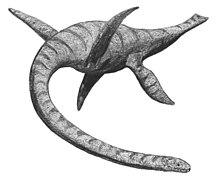
Like all
The interpretation by Frey & Riess became the dominant one, but was challenged in 2004 by Sanders, who showed experimentally that, whereas an alternate movement might have caused excessive pitching, a simultaneous movement would have caused only a slight pitch, which could have been easily controlled by the hind flippers. Of the other axial movements, rolling could have been controlled by alternately engaging the flippers of the right or left side, and yaw by the long neck or a vertical tail fin. Sanders did not believe that the hind pair was not used for propulsion, concluding that the limitations imposed by the hip joint were very relative.[107] In 2010, Sanders & Carpenter concluded that, with an alternating gait, the turbulence caused by the front pair would have hindered an effective action of the hind pair. Besides, a long gliding phase after a simultaneous engagement would have been very energy efficient.[104] It is also possible that the gait was optional and was adapted to the circumstances. During a fast steady pursuit, an alternate movement would have been useful; in an ambush, a simultaneous stroke would have made a peak speed possible. When searching for prey over a longer distance, a combination of a simultaneous movement with gliding would have cost the least energy.[108] In 2017, a study by Luke Muscutt, using a robot model, concluded that the rear flippers were actively employed, allowing for a 60% increase of the propulsive force and a 40% increase of efficiency. There would not have been a single optimal phase for all conditions, the gait likely having been changed as the situation demanded.[109]
Speed
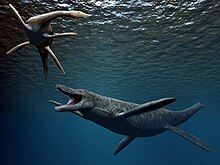
In general, it is hard to determine the maximum speed of extinct sea creatures. For plesiosaurs, this is made more difficult by the lack of consensus about their flipper stroke and gait. There are no exact calculations of their
Massare also tried to compare the speeds of plesiosaurs with those of the two other main sea reptile groups, the
The many plesiosaur species may have differed considerably in their swimming speeds, reflecting the various body shapes present in the group. While the short-necked "pliosauromorphs" (e.g.
Diving
Few data are available that show exactly how deep plesiosaurs dived. That they dived to some considerable depth is proven by traces of decompression sickness. The heads of the humeri and femora with many fossils show necrosis of the bone tissue, caused by a too rapid ascent after deep diving. However, this does not allow to deduce some exact depth as the damage could have been caused by a few very deep dives, or alternatively by a great number of relatively shallow descents. The vertebrae show no such damage: they were probably protected by a superior blood supply, made possible by the arteries entering the bone through the two foramina subcentralia, large openings in their undersides.[114]
Descending would have been helped by a negative
The relatively large eyes of the
Tail role
A 2020 study has posited that sauropterygians relied on vertical tail strokes much like
Metabolism
Traditionally, it was assumed that extinct reptile groups were cold-blooded like modern reptiles. New research during the past decades has led to the conclusion that some groups, such as
Reproduction
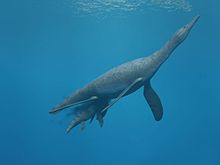
As reptiles in general are
An actual plesiosaur specimen found in 1987 eventually proved that plesiosaurs gave birth to live young:
Social behaviour and intelligence
From the parental care indicated by the large size of the young, it can be deduced that social behaviour in general was relatively complex.[126] It is not known whether plesiosaurs hunted in packs. Their relative brain size seems to be typical for reptiles. Of the senses, sight and smell were important, hearing less so; elasmosaurids have lost the stapes completely. It has been suggested that with some groups the skull housed electro-sensitive organs.[128][129]
Paleopathology
Some plesiosaur fossils show
Distribution
Plesiosaur fossils have been found on every continent, including Antarctica.[131]
Timeline of Plesiosauria Species
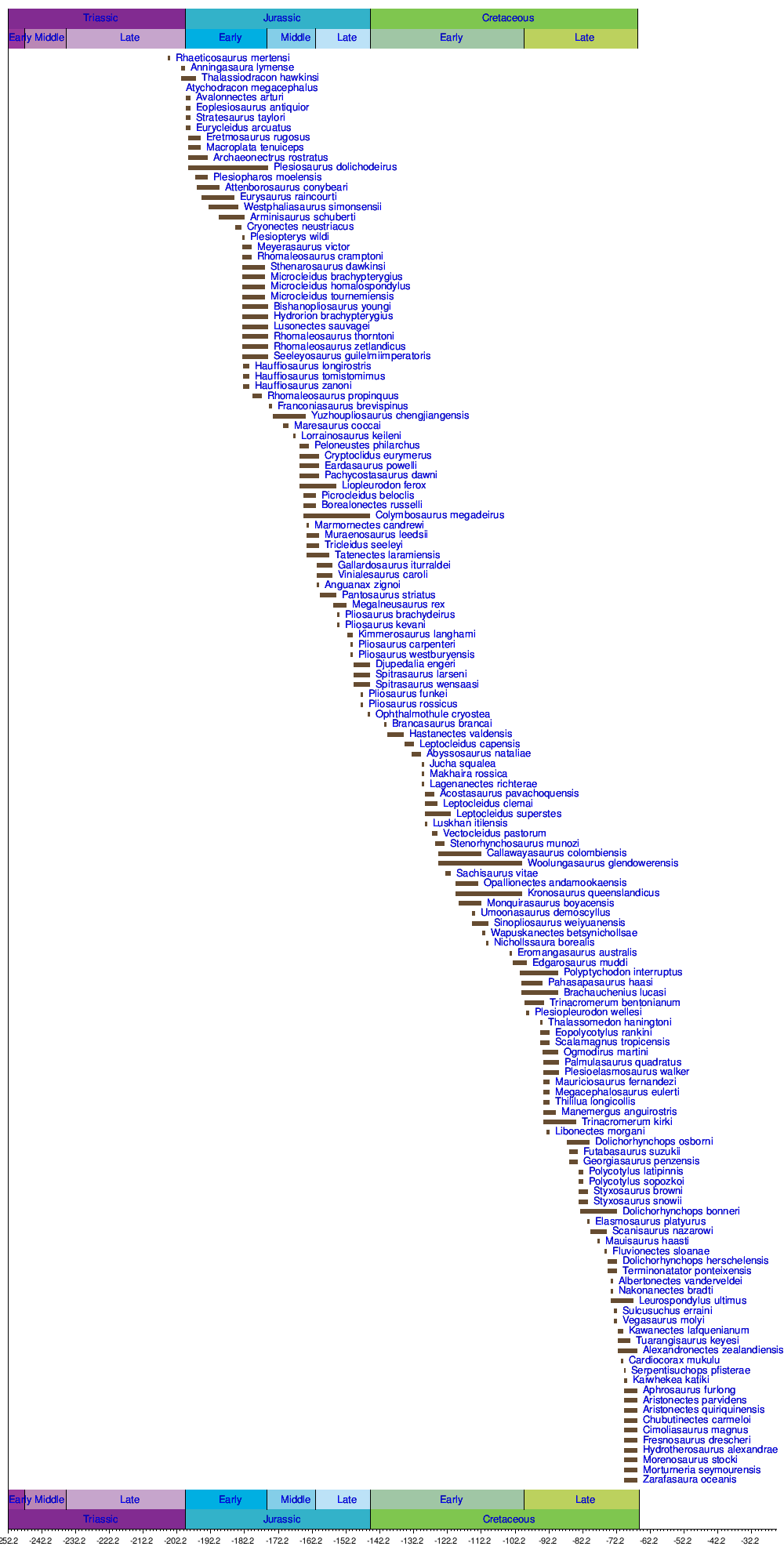
Stratigraphic distribution
The following is a list of geologic formations that have produced plesiosaur fossils.
In contemporary culture
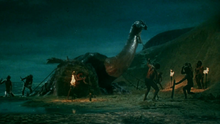
The belief that plesiosaurs are dinosaurs is a common misconception, and plesiosaurs are often erroneously depicted as dinosaurs in popular culture.[137][138]
It has been suggested that
While the
See also
- List of plesiosaur type specimens
- List of plesiosaurs
References
- ^ "PBDB". paleobiodb.org. Retrieved 2021-07-11.
- ^ "Plesiosaur". Merriam-Webster.com Dictionary.
- ^ "Plesiosaur". Dictionary.com Unabridged (Online). n.d.
- ^ Colbert, Edwin H. (Edwin Harris); Knight, Charles Robert (1951). The dinosaur book: the ruling reptiles and their relatives. New York: McGraw-Hill. p. 153.
- ^ "The Plesiosaur Directory". Archived from the original on 4 March 2016. Retrieved 20 April 2013.
- ^ "Plesiosaur fossils found in the Sahara suggest they weren't just marine animals". ScienceDaily. 27 July 2022. Archived from the original on 29 July 2022. Retrieved 3 August 2022.
- ^ ISBN 978-1-86239-311-0.
- ^ Richard Verstegan, 1605, A restitution of decayed intelligence or Nationum Origo, R. Bruney, Antwerpen
- ^ Lhuyd, E., 1699, Lithophylacii Brittannici Ichnographia, sive Lapidum aliorumque Fossilium Brittanicorum singulari figurà insignium, Londen
- .
- ^ Nicholls, J., 1795, The History and Antiquities of the County of Leicestershire. Volume I, John Nicholls, Londen
- S2CID 129545314.
- ^ De la Beche, H.T.; Conybeare, W.D. (1821). "Notice of the discovery of a new animal, forming a link between the Ichthyosaurus and crocodile, together with general remarks on the osteology of Ichthyosaurus". Transactions of the Geological Society of London. 5: 559–594.
- ^ "Plesiosaur_Names". oceansofkansas.com.
- ^ Conybeare, W.D. (1824). "On the discovery of an almost perfect skeleton of the Plesiosaurus". Transactions of the Geological Society of London. 2: 382–389.
- PMID 23741520.
- ^ Hawkins, T. H. (1834). "Memoirs on Ichthyosauri and Plesiosauri; Extinct monsters of the ancient Earth" (PDF). Relfe and Fletcher. Archived from the original (PDF) on 2005-08-30.
- ^ Peterson, A. (2012). "Terrible lizards and the wrath of God: How 19th century Christianity and Romanticism affected visual representations of dinosaurs and our perceptions of the ancient world" (PDF). Stanford Undergraduate Research Journal.
- ^ Hawkins, T. H. (1840). The Book of the Great Sea-dragons, Ichthyosauri and Plesiosauri, Gedolim Taninum of Moses. Extinct Monsters of the Ancient Earth. W. Pickering, London. pp. 1–27.
- ^ Christopher McGowan, 2001, The Dragon Seekers, Cambridge, Massachusetts, Perseus Publishing
- ^ Owen, R (1841). "Description of some remains of a gigantic crocodilian saurian, probably marine, from the Lower Greensand at Hythe and of teeth from the same formation at Maidstone, referable to the genus Polyptychodon". Proceedings of the Geologists' Association. 3: 449–452.
- ^ Edward Gray, John (1825). "A Synopsis of the Genera of Reptiles and Amphibia, with a Description of some new Species". Annals of Philosophy (British Museum). 10: 193–217.
- ^ de Blainville, H. M. D. (1835). "Description de quelques espèces de reptiles de la Californie, précédée de l'analyse d'une système générale d'Erpetologie et d'Amphibiologie". Nouvelles Archives du Muséum d'Histoire Naturelle (in French). 4: 233–296.
- ^ Cope, E.D. (1868). "[A resolution thanking Dr. Theophilus Turner for his donation of the skeleton of Elasmosaurus platyurus]". Proc. Acad. Nat. Sci. Phila. 20: 314.
- ^ Cope, E.D. (1868). "Remarks on a new enaliosaurian, Elasmosaurus platyurus". Proceedings of the Academy of Natural Sciences of Philadelphia. 20: 92–93.
- ^ Cope, E.D. (1869). "On the reptilian orders Pythonomorpha and Streptosauria". Proceedings of the Boston Society of Natural History. XII: 250–266.
- ^ Cope, E.D. (1868). "On a new large enaliosaur". American Journal of Science Series. 46 (137): 263–264.
- ^ Cope, E. D. (1869). "Sauropterygia". Synopsis of the Extinct Batrachia and Reptilia of North America, Part I. New Series. Vol. 14. Transactions of the American Philosophical Society. pp. 1–235.
- ^ Leidy, J (1870). "On the Elasmosaurus platyurus of Cope". American Journal of Science Series. 49 (147): 392.
- JSTOR 1005355.
- ^ Cope, E.D. (1870). "On Elasmosaurus platyurus Cope". American Journal of Science Series. 50 (148): 140–141.
- ^ Ellis (2003), p. 129
- ^ Williston, S.W., 1914, Water Reptiles of the Past and Present. Chicago University Press. Chicago, Illinois. 251 pp
- S2CID 83904449.
- ^ Smith, A.S., 2003, Cladistic analysis of the Plesiosauria (Reptilia: Sauropterygia). Masters thesis in palaeobiology, University of Bristol, 91 pp
- .
- ^ Forrest, Richard. "Liopleurodon". The Plesiosaur Site. Archived from the original on 15 July 2011. Retrieved 18 September 2017.
- ^ Forrest, Richard. "The 'Monster of Aramberri'". The Plesiosaur Site. Archived from the original on 3 September 2011. Retrieved 18 September 2017.
- S2CID 251120888.
- ^ Forrest, Richard. "The Collard Plesiosaur". Archived from the original on 2013-01-17. Retrieved 31 October 2012.
- ^ Larkin, Nigel. "Preparing and conserving an important six-foot long Plesiosaur skeleton for Somerset Museum". Retrieved 31 October 2012.
- Bibcode:2005JPal...79..969S.
- ^ "Hallazgo de un ejemplar completo de plesiosaurio joven". Archived from the original on 2013-07-18. Retrieved 2013-04-22. (In Spanish)
- S2CID 85361720.
- ^ "Scientists discover massive Jurassic marine reptile". phys.org. Retrieved 2022-01-28.
- ^ "PREDATOR X - Naturhistorisk Museum". 21 March 2009. Archived from the original on 21 March 2009.
- ^ Hignett, Katherine (2017-12-22). "Plesiosaur: Ancient Sea Monster Discovered in Antarctica". Newsweek. Retrieved 2017-12-23.
- ^ Rieppel, O. (2000). Sauropterygia I. Handbuch der Paläoherpetologie (in German). Vol. 12A. Verlag Dr. Friedrich Pfeil. pp. 1–134.
- S2CID 4391810.
- .
- ^ a b Rieppel, O., 1997, "Introduction to Sauropterygia", In: Callaway, J. M. & Nicholls, E. L. (eds.), Ancient marine reptiles pp 107–119. Academic Press, San Diego, California
- S2CID 85753943.
- PMID 22438869.
- ^ S2CID 12193439.
- ^ Bakker, R.T. (1993). "Plesiosaur Extinction Cycles — Events that Mark the Beginning, Middle and End of the Cretaceous". In Caldwell, W.G.E.; Kauffman, E.G. (eds.). Evolution of the Western Interior Basin. Geological Association of Canada. pp. 641–664.
- .
- ^ S2CID 19710180.
- ^ Tarlo, L.B.H. (1959). "Stretosaurus gen nov., a giant pliosaur from the Kimmeridge Clay". Palaeontology. 2 (2): 39–55.
- ^ a b McHenry, Colin Richard (2009). "Devourer of Gods: the palaeoecology of the Cretaceous pliosaur Kronosaurus queenslandicus" (PDF): 1–460
- PMID 23741520.
- S2CID 258630597.
- ^ Caldwell, Michael W; 1997b. Modified perichondral ossification and the evolution of paddle-like limbs in Ichthyosaurs and Plesiosaurs; Journal of Vertebrate Paleontology 17 (3); 534-547
- ^ Storrs, Glenn W.; 1990. Phylogenetic Relationships of Pachypleurosaurian and Nothosauriform Reptiles (Diapsida: Sauropterygia); Journal of Vertebrate Paleontology; 10 (Supplement to Number 3)
- ^ S2CID 247668864.
- S2CID 129500470.
- S2CID 4353612.
- ^ Brown, D. S.; Cruickshank, A. R. I. (1994). "The skull of the Callovian plesiosaur Cryptoclidus eurymerus and the sauropterygian cheek". Palaeontology. 37 (4): 941–953.
- .
- ^ "Analysing The Skeleton: The Plesiosaur Diet". Analysing The Skeleton: The Plesiosaur Diet. Retrieved 2022-01-28.
- ^ Huene, F. von (1923). "Ein neuer Plesiosaurier aus dem oberen Lias Württembergs". Jahreshefte des Vereins für vaterländische Naturkunde in Württemberg. 79: 1–21.
- ^ Dames, W (1895). "Die Plesiosaurier der Süddeutschen Liasformation". Abhandlungen der Königlich Preussischen Akademie der Wissenschaften zu Berlin. 1895: 1–81.
- ^ Wilhelm, B.C., 2010, Novel anatomy of cryptoclidid plesiosaurs with comments on axial locomotion. Ph.D thesis, Marshall University, Huntington, WV. USA
- S2CID 36408899.
- ^ Smith, Adam S. (2013). "Morphology of the caudal vertebrae in Rhomaleosaurus zetlandicus and a review of the evidence for a tail fin in Plesiosauria". Paludicola. 9 (3): 144–158.
- ^ S2CID 211217453.
- S2CID 28832109.
- ^ "Plesiosaur bottom-feeding shown". BBC News. 17 October 2005. Retrieved 21 May 2012.
- S2CID 127249009.
- S2CID 91144814.
- ^ Chatterjee, S. and Small, B.J., 1989, "New plesiosaurs from the Upper Cretaceous of Antarctica", In: Crame, J. (ed) Origins and Evolution of Antarctic Biota, pp. 197-215, Geological Society Publishing House, London
- ^ "The Plesiosaur Directory". Retrieved 20 April 2013.
- ^ Massare, J.A. (1992). "Ancient mariners". Natural History. 101: 48–53.
- .
- ^ Everhart, M. J. (2005). "Bite marks on an elasmosaur (Sauropterygia; Plesiosauria) paddle from the Niobrara Chalk (Upper Cretaceous) as probable evidence of feeding by the lamniform shark, Cretoxyrhina mantelli". Vertebrate Paleontology. 2 (2): 14–24.
- ^ Everhart, M. J. (2004). "Plesiosaurs as the food of mosasaurs; new data on the stomach contents of a Tylosaurus proriger (Squamata; Mosasauridae) from the Niobrara Formation of western Kansas". The Mosasaur. 7: 41–46.
- ^ Williston, Samuel Wendel; 1904. The stomach stones of the plesiosaurs Science 20; 565
- JSTOR 3627940.
- ^ Cerda, A; Salgado, L (2008). "Gastrolitos en un plesiosaurio (Sauropterygia) de la Formación Allen (Campaniano-Maastrichtiano), provincia de Río Negro, Patagonia, Argentina". Ameghiniana. 45: 529–536.
- S2CID 130607702.
- doi:10.1144/gsl.jgs.1877.033.01-04.32 – via Wikisource.
- ^ Welles, S.P.; Bump, J.D. (1949). "Alzadasaurus pembertoni, a new elasmosaur from the Upper Cretaceous of South Dakota". Journal of Paleontology. 23 (5): 521–535.
- ^ Everhart, M.J. (2000). "Gastroliths associated with plesiosaur remains in the Sharon Springs Member of the Pierre Shale (late Cretaceous), Western Kansas". Kansas Academy of Sciences Transactions. 103 (1–2): 58–69.
- S2CID 128969768.
- ^ Fraas, E (1905). "Reptilien und Säugetiere in ihren Anpassungserscheinungen an das marine Leben". Jahresheften des Vereins für vaterländische Naturkunde in Württemberg. 29: 347–386.
- ^ Abel, O (1908). "Die Anpassungsformen der Wirbeltiere an das Meeresleben". Schriften des Vereines zur Verbreitung Naturwissenschaftlicher Kenntnisse in Wien. 48 (14): 395–422.
- .
- ^ Tarlo, L.B. (1957). "The scapula of Pliosaurus macromerus Phillips". Palaeontology. 1: 193–199.
- S2CID 219541473.
- ^ Robinson, J.A. (1975). "The locomotion of plesiosaurs". Neues Jahrbuch für Geologie und Paläontologie, Abhandlungen. 149 (3): 286–332.
- ^ Robinson, J.A. (1977). "Intercorporal force transmission in plesiosaurs". Neues Jahrbuch für Geologie und Paläontologie, Abhandlungen. 153 (1): 88–128.
- .
- .
- .
- ^ S2CID 86491931.
- ^ Riess, J. and E. Frey, 1991. "The evolution of underwater flight and the locomotion of plesiosaurs", In: J.M.V. Rayner and R.J. Wootton (eds.) Biomechanics in Evolution, Cambridge, England: Cambridge University Press, pp. 131-144
- .
- S2CID 220415208.
- S2CID 1869747.
- PMID 28855360.
- S2CID 85810360.
- ^ a b Massare, J. A., 1994, "Swimming capabilities of Mesozoic marine reptiles: a review", In: L. Maddock et al. (eds.) Mechanics and Physiology of Animal Swimming, Cambridge, England: Cambridge University Press pp. 133-149
- S2CID 56387158.
- S2CID 53642687.
- S2CID 86226384.
- S2CID 10700992.
- ^ Taylor, M.A., 1993, "Stomach stones for feeding or buoyancy? The occurrence and function of gastroliths in marine tetrapods", Philosophical Transactions of the Royal Society of London B 341: 163–175
- .
- ^ A. Yu. Berezin 2019 "Morphofunctional features of the plesiosaur Abyssosaurus nataliae (Plesiosauroidea: Plesiosauria) in connection with adaptations to a deep-water lifestyle." Ministry of National Resources and Ecology of the Russian Federation [in Russian].
- PMID 20657768.
- PMID 23773234.
- PMID 29892509.
- S2CID 206525584.
- ^ Seeley, H.G. (1888). "On the Mode of Development of the Young in Plesiosaurus". Report of the British Association for the Advancement of Science; Held at Manchester September. 1887: 697–698.
- ^ Seeley, H. G.; 1896; "On a pyritous concretion from the Lias of Whitby which appears to show the external form of the body of embryos of a species of Plesiosaurus", Annual Report of Yorkshire philosophical Society pp.20-29
- ^ Thulborn, R.A. (1982). "Liassic plesiosaur embryos reinterpreted as shrimp burrows". Palaeontology. 25: 351–359.
- ^ S2CID 36165835.
- ^ Welsh, Jennifer (11 August 2011). "Pregnant Fossil Suggests Ancient 'Sea Monsters' Birthed Live Young". LiveScience. Retrieved 21 May 2012.
- S2CID 131429825.
- S2CID 7406418.
- .
- ^ Chatterjee, Sankar; Small, Brian J.; Nickell, M. W. (1984). "Late Cretaceous marine reptiles from Antarctica;". Antarctic Journal of the United States. 19 (5): 7–8.
- ^ ماذا تعرفون عن الـ"بليزوصور"؟ شاهدوا ما تم اكتشافه في سوريا مؤخراً. CNN (in Arabic). 30 August 2017.
- PMID 29242826.
- ^ "Material: YPM 1640," in "The Occurrence of Elasmosaurids..." Everhart (2006), page 173.
- ^ a b c d "Table 13.1: Plesiosaurs," in Everhart (2005) Oceans of Kansas, page 245.
- ^ "Material: YPM 1640," in "The Occurrence of Elasmosaurids..." Everhart (2006), page 172.
- ^ "Famous Prehistoric Animals That Weren't Actually Dinosaurs". Feb 17, 2021.
- ^ "The real sea monsters". Science News for Students. 2015-06-19. Retrieved 2022-02-12.
- ^ Anonymous (AP Report). Japanese scientist says that sea creature could be related to a shark species. The New York Times, 26 July 1977.
- ^ "Sea-Monster or Shark: An Alleged Plesiosaur Carcass". paleo.cc.
- ^ Kimura S, Fujii K, and others. The morphology and chemical composition of the horny fiber from an unidentified creature captured off the coast of New Zealand. In CPC 1978, pp. 67–74.
- ISBN 978-1-60520-332-4p. 321.
- ^ "Life". New Scientist.
- ^ "Crawley Creatures". www.crawley-creatures.com. Archived from the original on 2009-05-21. Retrieved 2013-04-22.
- ^ Ellis (2003), pp. 1–3.
Further reading
- Callaway, J. M.; Nicholls, E. L. (1997). "Sauropterygia". Ancient Marine Reptiles. Academic Press. ISBN 978-0-12-155210-7.
- Carpenter, K (1996). "A review of short-necked plesiosaurs from the Cretaceous of the western interior, North America" (PDF). Neues Jahrbuch für Geologie und Paläontologie, Abhandlungen. 201 (2): 259–287. .
- Carpenter, K. 1997. Comparative cranial anatomy of two North American Cretaceous plesiosaurs. Pp 91–216, in Calloway J. M. and E. L. Nicholls, (eds.), Ancient Marine Reptiles, Academic Press, San Diego.
- Carpenter, K (1999). "Revision of North American elasmosaurs from the Cretaceous of the western interior". Paludicola. 2 (2): 148–173.
- Cicimurri, D.; Everhart, M. (2001). "An Elasmosaur with Stomach Contents and Gastroliths from the Pierre Shale (Late Cretaceous) of Kansas". Trans. Kans. Acad. Sci. 104 (3 & 4): 129–143. S2CID 86037286.
- Cope, E. D. (1868). "Remarks on a new enaliosaurian, Elasmosaurus platyurus". Proceedings of the Academy of Natural Sciences of Philadelphia. 20: 92–93.
- Ellis, R. 2003: Sea Dragons (Kansas University Press)
- Everhart, M. J. (2002). "Where the elasmosaurs roamed". Prehistoric Times. 53: 24–27.
- Everhart, M.J. 2005. "Where the Elasmosaurs roamed," Chapter 7 in Oceans of Kansas: A Natural History of the Western Interior Sea, Indiana University Press, Bloomington, 322 p.
- Everhart, M.J. 2005. Oceans of Kansas: A Natural History of the Western Interior Sea. Indiana University Press, Bloomington, 322 pp.
- Everhart, M.J. (2005). "Gastroliths associated with plesiosaur remains in the Sharon Springs Member (Late Cretaceous) of the Pierre Shale, Western Kansas". Kansas Acad. Sci. Trans. 103 (1–2): 58–69.
- Everhart, Michael J (2006). "The Occurrence of Elasmosaurids (Reptilia: Plesiosauria) in the Niobrara Chalk of Western Kansas". Paludicila. 5 (4): 170–183.
- Hampe, O., 1992: Courier Forsch.-Inst. Senckenberg 145: 1-32
- Lingham-Soliar, T. (1995). "in". Phil. Trans. R. Soc. Lond. 347: 155–180.
- O'Keefe, F. R. (2001). "A cladistic analysis and taxonomic revision of the Plesiosauria (Reptilia: Sauropterygia);". Acta Zool. Fennica. 213: 1–63.
- ( ), 1997: in Reports of the National Center for Science Education, 17.3 (May/June 1997) pp 16–28.
- Kaddumi, H. F., 2009. Fossils of the Harrana Fauna and the adjacent areas. Publications of the Eternal River Museum of Natural History, Jordan. 324 pp.
- Storrs, G. W., 1999. An examination of Plesiosauria (Diapsida: Sauropterygia) from the Niobrara Chalk (Upper Cretaceous) of central North America, University of Kansas Paleontologcial Contributions, (N.S.), No. 11, 15 pp.
- Welles, S. P. 1943. Elasmosaurid plesiosaurs with a description of the new material from California and Colorado. University of California Memoirs 13:125-254. figs.1-37., pls.12-29.
- Welles, S. P. 1952. A review of the North American Cretaceous elasmosaurs. University of California Publications in Geological Science 29:46-144, figs. 1-25.
- Welles, S. P. 1962. A new species of elasmosaur from the Aptian of Columbia and a review of the Cretaceous plesiosaurs. University of California Publications in Geological Science 46, 96 pp.
- White, T., 1935: in Occasional Papers Boston Soc. Nat. Hist. 8: 219-228
- Williston, S. W. 1890. A new plesiosaur from the Niobrara Cretaceous of Kansas. Transactions of the Kansas Academy of Science 12:174-178, 2 fig.
- Williston, S. W. (1902). "Restoration of Dolichorhynchops osborni, a new Cretaceous plesiosaur". Kansas University Science Bulletin. 1 (9): 241–244, 1 plate.
- Williston, S. W. 1903. North American plesiosaurs. Field Columbian Museum, Publication 73, Geology Series 2(1): 1-79, 29 pl.
- Williston, S. W. (1906). "North American plesiosaurs: Elasmosaurus, Cimoliasaurus, and Polycotylus". American Journal of Science. 21 (123): 221–234, 4 pl. .
- Williston, S. W. (1908). "North American plesiosaurs: Trinacromerum". Journal of Geology. 16 (8): 715–735. doi:10.1086/621573.
- Bardet, Nathalie; Cappetta, Henri; Pereda Suberbiola, Xabier (2000). "The marine vertebrate faunas from the Late Cretaceous phosphates of Syria". Geological Magazine. 137 (3). Cambridge University: 269–290. S2CID 129600143.
External links
- The Plesiosaur Site. Richard Forrest.
- The Plesiosaur Directory. Adam Stuart Smith.
- Plesiosauria technical definition at the Plesiosaur Directory
- Plesiosaur FAQ's. Raymond Thaddeus C. Ancog.
- Oceans of Kansas Paleontology. Mike Everhart.
- "Plesiosaur fossil found in Bridgwater Bay". Somersert Museums County Service. (best known fossil)
- "Fossil hunters turn up 50-ton monster of prehistoric deep". Allan Hall and Mark Henderson. Times Online, December 30, 2002. (Monster of Aramberri)
- Triassic reptiles had live young.
- Bridgwater Bay juvenile plesiosaur
- Just How Good Is the Plesiosaur Fossil Record? Laelaps Blog.
